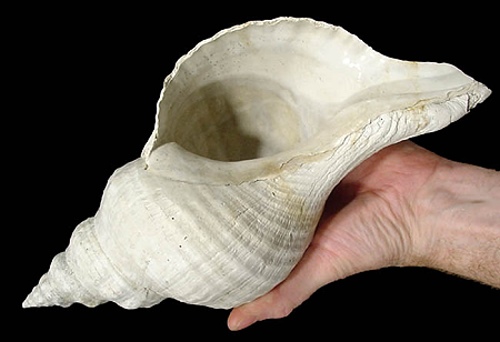|
Question:
This is
something I observed some years ago in a Victoria, BC aquarium which
I have not seen described:
In a tank were two Pacific Octopuses. They were pressed together ventral
surface to ventral surface. What was striking was that each sucker connected
exactly with the corresponding sucker of the other. They were obviously
aroused, as they were each paper white. After about ten minutes they
separated and normal colour returned.
Can you
tell me what I witnessed?
Herb
Send
Ideas to: Herb
|
|
Discussions:
-
Whether or not it is a fossil depends on the
age of the specimen. That horse conch (Triplofusus giganteus) probably
was dug up from a Pliocene or Pleistocene deposit in southern Florida.
In the field, far from the ocean, surrounded by shells, sand and
clay, it is clearly from a time (Ice Age or older) much older than
now. Clean it up, and there is no obvious way to tell just how old
it is. Incidentally, beach shells in many areas (famously Calvert
Cliffs, Maryland) include fossils weathered out of the nearby sediments.
Some other areas have Pleistocene (Ice Age) shells washed up onto
the beach from underwater deposits. These can only be distinguished
as fossils because the species no longer lives there.
Coral is the skeleton of colonial polyps. When they die, and the
coral is bleached by the sun, it may look like a fossil, but again
it is the age that is critical. If the corals in Aruba were growing
during a time when the water level was much higher, they probably
are fossils. But if they are just sitting around, maybe they are
Recent corals that were transported by people. ... Allen A.
-
Most Cenozoic fossils (under 65 million years
old) are original shell material. If they occur in rock being eroded
by the sea, you may not be able to tell whether they are Recent
or fossil unless you know the fauna(s). There is a locality about
100km north of here where early Miocene fossils are washing out
of a beach outcrop and others are washing in from pliocene rocks
on the shallow seabed... so the beach has Miocene, Pliocene and
Recent shells washing-up... and the fossils look as good as the
Recent ones.
To be a fossil a shell must have been buried in a rock unit as the
unit was being formed... the rock can be sedimentary (sandstone,
limestone, musdtone etc), volcanosedimentary (airfall ash deposits
ie tuffs) or volcanic (lava flows). Tuffs can have really good mollusc
faunas! The rock need not be hard... indeed, it can be loose (unconsolidated).
I guess, though there is no set rule, the shells should be fairly
old... say over 500,000 years. However crabs in burrows which are
hardening to concretions in harbor sediments near here right now
would have to be considered fossils, even though they are only a
few years old. And a shell which died 1 million years ago and has
been lying loose on the seafloor ever since is not a fossil (these
occur off the SE New Zealand shore too). I might meet some of these
when I go out on the Otago University's Marine Sciences Dept boat
tomorrow.
Coral skeletons are biogenic rocks... and old uplifted reefs can
be considered to be fossil. These occur in the Caribbean and SE
Asia. ...Andrew G.
-
Many Cenozoic molluscan fossils (ie those under
65 million years old) are original shell material. If they occur
in rock being eroded by the sea, you may not be able to tell whether
they are Recent or fossil unless you know the fauna(s). There is
a locality about 100km north of here where early Miocene fossils
are washing out of a beach outcrop and others are washing in from
Pliocene rocks on the shallow seabed... so the beach has Miocene,
Pliocene and Recent shells washing-up... and the fossils look as
good as the Recent ones.
To be a fossil a shell must have been buried
in a rock unit as the unit was being formed... the rock can be sedimentary
(sandstone, limestone, musdtone etc), volcanosedimentary (airfall
ash deposits ie
tuffs) or volcanic (lava flows). Tuffs can have really good mollusc
faunas! The rock need not be hard... indeed, it can be loose (unconsolidated).
I guess, though there is no set rule, the shells should be fairly
old... say over 500,000 years. However crabs in burrows which are
hardening to concretions in harbor sediments near here right now
would have to be considered fossils, even though they are only a
few years old. And a shell which died 1 million years ago and has
been lying loose on the seafloor ever since is not a fossil (these
occur off the SE New Zealand shore too).
Coral skeletons are biogenic rocks... and old
uplifted reefs can definitely be considered to be fossil. These
occur in the Caribbean and SE Asia.
|
